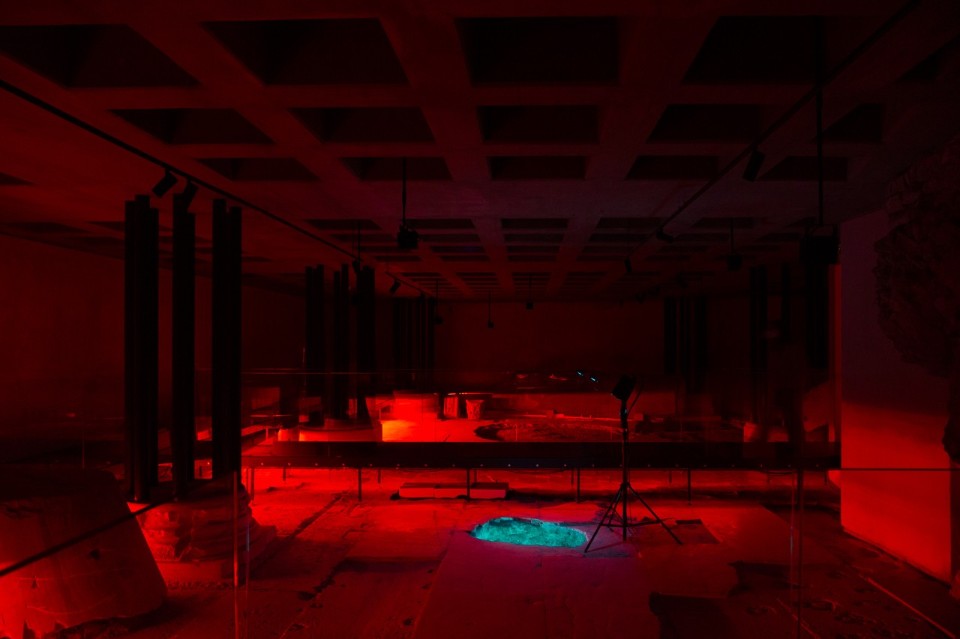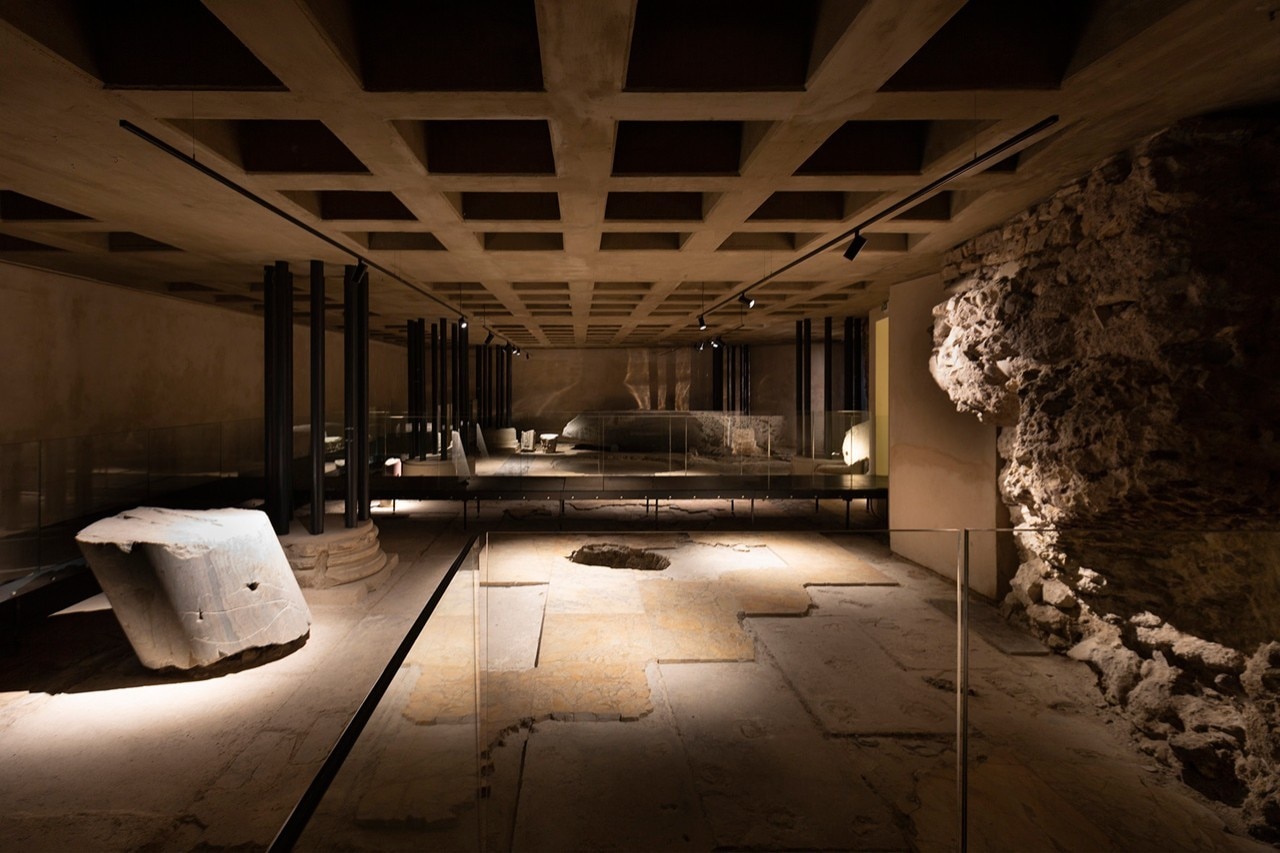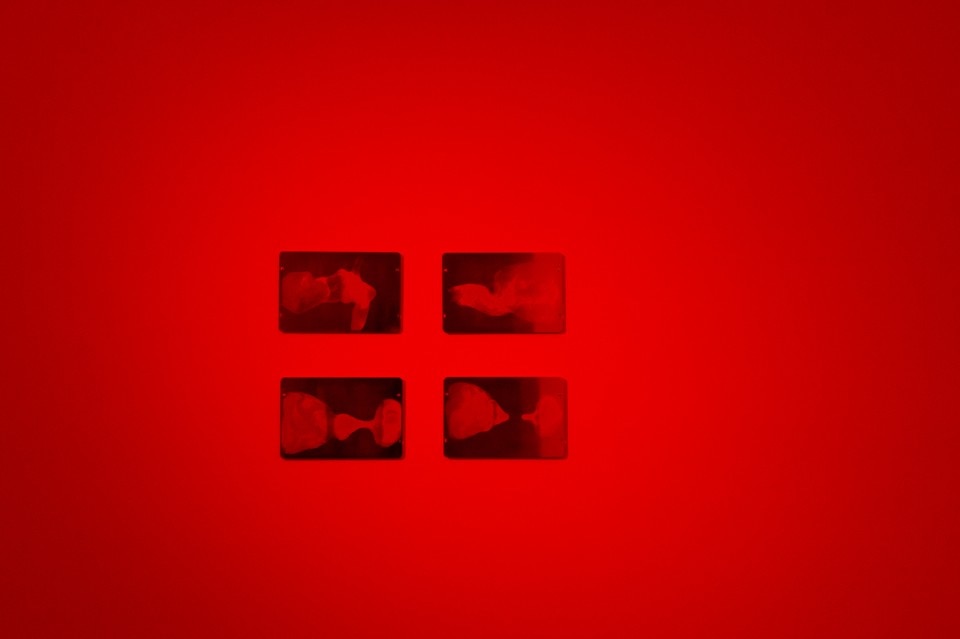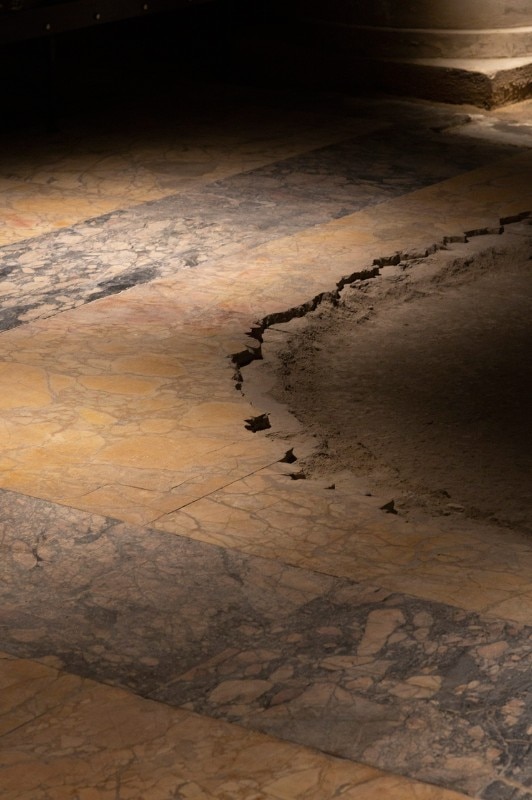Palazzo Roccagiovine is a 19th-century building, an object from the last years of papal kingdom, facing the Trajan’s Forum with an almost anonymous politeness, acting as an appropriate backdrop to the spectacle of archaeological Rome. The two openings on the ground floor express the same attitude, by concealing the sequence of spaces in FOROF, the palindromic name for a new space claiming to be inspired by a fluidity between contemporary art, archaeology and the city, “a continuous descent into the past, through history and archaeology, and a subsequent ascent into the present and the contemporary”, as its creator, Giovanna Caruso Fendi, has defined it.
The descent is also physical: the heart of FOROF is in fact beating in the basement, where the ruins of the Basilica Ulpia are located, with the marble floor of its eastern apse now becoming part of a journey through the new exhibition space.
Caruso Fendi has tapped the Rome-based firm IT’S Studio to reimagine the spaces leading to this underground core. “We were asked for a minimal operation that could take this place beyond the usual white-cube stereotype” says Paolo Mezzalama, founding partner at IT’S, “to generate a space that could be Roman. To us, ‘romanity’ is first and foremost a matter of light: the rooms intercept the light of Rome according to an infinitesimal gradient of chromatic tones, and so does the new floor in made by specialized craftsmen in the ancient technique of cocciopesto”.

Three rooms are arranged on the ground floor: a bookshop, a room for meetings and lectures, and a bar; they are deliberately put in continuity, Mezzalama continues, “as their function is to connect the installations to Rome, and to give the artists the opportunity to share their time with the public on the occasion of special events, which are a fundamental part of the concept”. The first of the list has featured Paul B. Preciado, part and soul of the fragmented voice speaking to us from the future of sexuality in LOVOTIC, a debut project for FOROF, which has brought together Soundwalk Collective, Charlotte Gainsbourg, Lyra Pramuk, Atom™, and Willem Dafoe.
More than a conventional gallery or art space, FOROF reveals through an articulated programme an intention to engage with the city and its cultural fabric, which Domus has wanted to explore in depth with Giovanna Caruso Fendi.

A first aspect: Forof is site-specific, it participates in the nature of the city. When asked about her position in this regard, Giovanna Caruso Fendi has shown no doubts: “I believe that, since it is born in Rome, so deeply embedded in the historical fabric of the city, Forof could not have existed anywhere else."
The purpose of the interior renovation, the choice of materials and the gradient of warm colours that reshape the spaces of this bygone print shop — replacing a white-wall / black-floor system left by a previous refurbishment — is precisely to take us on a journey into the depths of an organism, stretching between two different times, that is historic Rome. The effect is maximised by the new intervention, slipping across darker color tones as it connects with the walkways in the basement, a pathway that detaches the visitor from the material mass of the building, floating between the load-bearing walls of the palazzo, the basilica Ulpia, and the steel shoring supporting its covering slab.

Concept-oriented is then a second key to the project. If we return to the ground level (which communicates with the lower level through a linear glazed gap in the floor) the research on details, on the layout of all elements, has aimed to stress the continuity of spaces while at the same time supporting the new Forof programme by making the practice of visiting, discussing, meeting and sharing as natural as possible. This can be remarked in the reflecting folding walls around the bar and the stairwell, in the false walls which house the installations while respecting the original structure, in the artificial lighting — developed with the Barcelona-based studio Artec3 — which is indirect yet so present that it can be perceived as a physical architectural element.

All these aspects are components of an exchange with the city, aiming to work in two ways, not just absorbing the city inside, but also coming out of the the walls of Forof to participate in the life of the city itself. “Giving opportunities to contemporary creativity in a city like this helps a lot in interpreting its artistic heritage, since the latter would otherwise face the risk to marginalise and crush the former”. This is how Caruso Fendi has summarised the space-based dynamics that Forof aims to generate. We therefore wondered if we are witnessing the expression of a new form of urban patronage, and here too the answer has left no room for equivocation: “‘Patronage’ is to be understood in its proper meaning: ‘the attitude of one who promotes the arts by lavishly protecting those who cultivate them’. My benefit organization” says Caruso Fendi “a contemporary version of patronage, has this aim: supporting artists in their evolution while offering society new cultural opportunities and nourishing reflection on contemporary issues, always looking back at history.

Opening image: LOVOTIC by Soundwalk Collective, FOROF, Rome, 2022. Photo Jacopo Tomassini

Innovation and sustainability in building materials
The new range of lime-based thermal plasters by Röfix is designed to provide advanced insulation solutions.



















